Chemical Contamination of Food and Water
VerifiedAdded on 2023/06/13
|12
|4270
|393
AI Summary
This report discusses three case studies related to chemical contamination of food and water, identifying possible hazards, their origin, health effects, and control measures. The first case study focuses on instant spices chai drink, the second case study discusses BPA, brevetoxin, and melamine contaminants, and the third case study explores aflatoxins. The report also highlights relevant UK and EU legislation and control measures to prevent contamination.
Contribute Materials
Your contribution can guide someone’s learning journey. Share your
documents today.

CHEMICAL
CONTAMINATION
OF FOOD AND
WATER
CONTAMINATION
OF FOOD AND
WATER
Secure Best Marks with AI Grader
Need help grading? Try our AI Grader for instant feedback on your assignments.
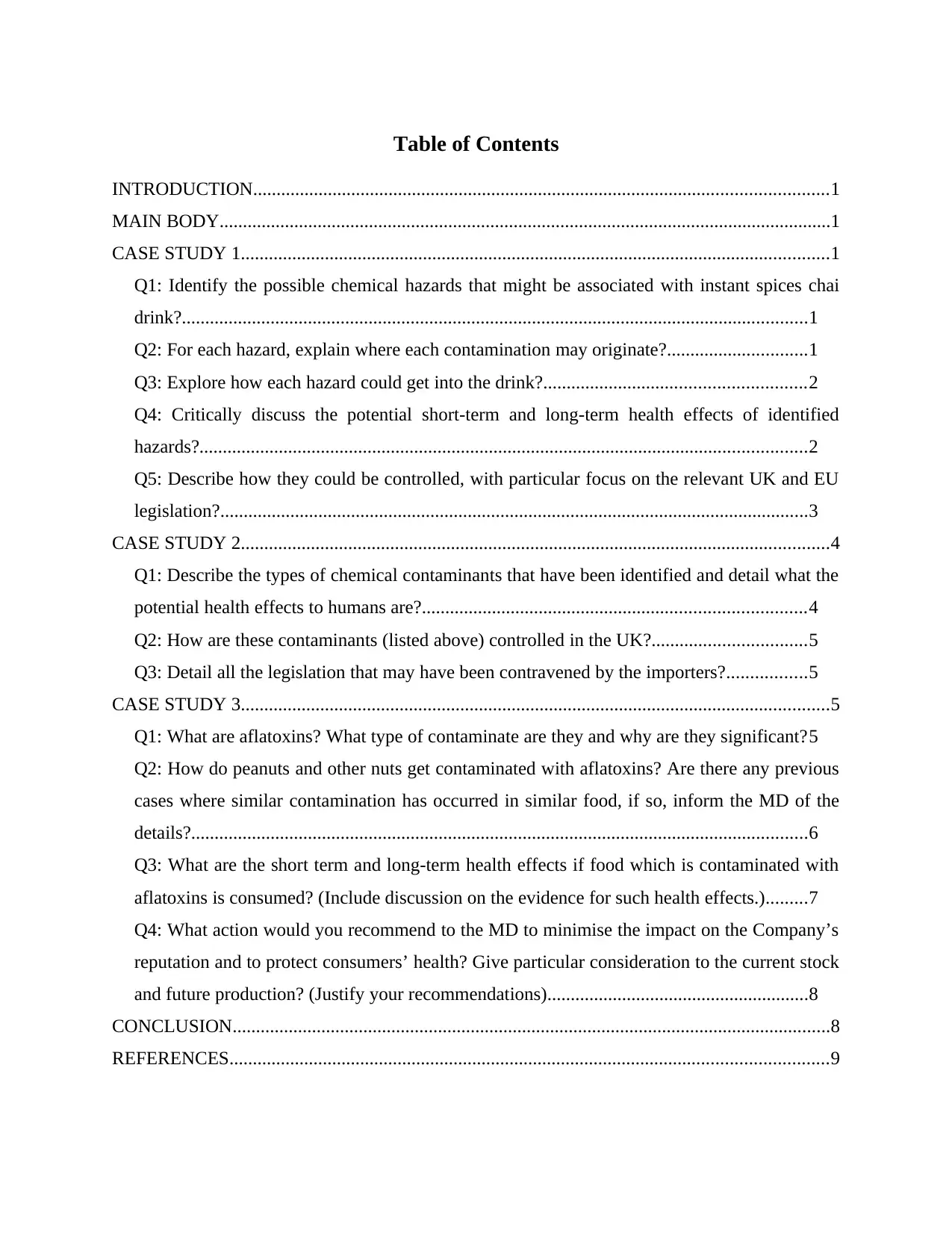
Table of Contents
INTRODUCTION...........................................................................................................................1
MAIN BODY...................................................................................................................................1
CASE STUDY 1..............................................................................................................................1
Q1: Identify the possible chemical hazards that might be associated with instant spices chai
drink?......................................................................................................................................1
Q2: For each hazard, explain where each contamination may originate?..............................1
Q3: Explore how each hazard could get into the drink?........................................................2
Q4: Critically discuss the potential short-term and long-term health effects of identified
hazards?..................................................................................................................................2
Q5: Describe how they could be controlled, with particular focus on the relevant UK and EU
legislation?..............................................................................................................................3
CASE STUDY 2..............................................................................................................................4
Q1: Describe the types of chemical contaminants that have been identified and detail what the
potential health effects to humans are?..................................................................................4
Q2: How are these contaminants (listed above) controlled in the UK?.................................5
Q3: Detail all the legislation that may have been contravened by the importers?.................5
CASE STUDY 3..............................................................................................................................5
Q1: What are aflatoxins? What type of contaminate are they and why are they significant?5
Q2: How do peanuts and other nuts get contaminated with aflatoxins? Are there any previous
cases where similar contamination has occurred in similar food, if so, inform the MD of the
details?....................................................................................................................................6
Q3: What are the short term and long-term health effects if food which is contaminated with
aflatoxins is consumed? (Include discussion on the evidence for such health effects.).........7
Q4: What action would you recommend to the MD to minimise the impact on the Company’s
reputation and to protect consumers’ health? Give particular consideration to the current stock
and future production? (Justify your recommendations)........................................................8
CONCLUSION................................................................................................................................8
REFERENCES................................................................................................................................9
INTRODUCTION...........................................................................................................................1
MAIN BODY...................................................................................................................................1
CASE STUDY 1..............................................................................................................................1
Q1: Identify the possible chemical hazards that might be associated with instant spices chai
drink?......................................................................................................................................1
Q2: For each hazard, explain where each contamination may originate?..............................1
Q3: Explore how each hazard could get into the drink?........................................................2
Q4: Critically discuss the potential short-term and long-term health effects of identified
hazards?..................................................................................................................................2
Q5: Describe how they could be controlled, with particular focus on the relevant UK and EU
legislation?..............................................................................................................................3
CASE STUDY 2..............................................................................................................................4
Q1: Describe the types of chemical contaminants that have been identified and detail what the
potential health effects to humans are?..................................................................................4
Q2: How are these contaminants (listed above) controlled in the UK?.................................5
Q3: Detail all the legislation that may have been contravened by the importers?.................5
CASE STUDY 3..............................................................................................................................5
Q1: What are aflatoxins? What type of contaminate are they and why are they significant?5
Q2: How do peanuts and other nuts get contaminated with aflatoxins? Are there any previous
cases where similar contamination has occurred in similar food, if so, inform the MD of the
details?....................................................................................................................................6
Q3: What are the short term and long-term health effects if food which is contaminated with
aflatoxins is consumed? (Include discussion on the evidence for such health effects.).........7
Q4: What action would you recommend to the MD to minimise the impact on the Company’s
reputation and to protect consumers’ health? Give particular consideration to the current stock
and future production? (Justify your recommendations)........................................................8
CONCLUSION................................................................................................................................8
REFERENCES................................................................................................................................9

INTRODUCTION
The contamination is defined as transmission of infection with medium within food or water or
any source make primary source inflected is called as contamination. The food and water borne
disease is usually affected human body and it is usually caused with aspect of toxin which is
formulated with aspect of growing bacteria. The toxin is usually produced with various of
impactful algal species. The contamination of food and water with appropriate kind of bacteria,
virus and parasite. It may cause food poisoning and other associated disease that happen when
someone used to eat food which is show presence of harmful bacteria. In this report major of
discussion is based on three case study which is aspect with contamination (Andrade and et. al.,
2018).
MAIN BODY
CASE STUDY 1
Q1: Identify the possible chemical hazards that might be associated with instant spices chai
drink?
The preparation of the tea is usually defined as the composition of water and milk. The
chance of water contamination is higher in the case of instant spice chai drink due to the
chemical toxin which present in water such as Lead and many more. In addition, the milk
contamination is also shown which contain excess of lacto class of bacteria which may arise
issue during the chai preparation. In addition, chemical hazards are usually occurring when clove
which is ingredient of spice chai drink is taken by pregnant women than then used to show side
effect within pregnant women. The clove has some of side effect which is related with people
with aspect of histaminergic aspect that is nausea, vomiting and many more. Therefore, the
aluminium foil is usually ban in some of the countries due chemical reaction which is taken
within the spice chai drink may create issue of cardiac hypertrophy. It also minimises red blood
cell in body and causing the issue of anaemia (Karampoula and et. al., 2019).
Q2: For each hazard, explain where each contamination may originate?
The mycotoxin production in tea is usually show their occurrence at the any of stage of its
manufacturing. It occurs through tea bush, cultivation, harvest, processing and storage, and also
show their origin due to poor agricultural practice, improper processing, drying and so on which
1
The contamination is defined as transmission of infection with medium within food or water or
any source make primary source inflected is called as contamination. The food and water borne
disease is usually affected human body and it is usually caused with aspect of toxin which is
formulated with aspect of growing bacteria. The toxin is usually produced with various of
impactful algal species. The contamination of food and water with appropriate kind of bacteria,
virus and parasite. It may cause food poisoning and other associated disease that happen when
someone used to eat food which is show presence of harmful bacteria. In this report major of
discussion is based on three case study which is aspect with contamination (Andrade and et. al.,
2018).
MAIN BODY
CASE STUDY 1
Q1: Identify the possible chemical hazards that might be associated with instant spices chai
drink?
The preparation of the tea is usually defined as the composition of water and milk. The
chance of water contamination is higher in the case of instant spice chai drink due to the
chemical toxin which present in water such as Lead and many more. In addition, the milk
contamination is also shown which contain excess of lacto class of bacteria which may arise
issue during the chai preparation. In addition, chemical hazards are usually occurring when clove
which is ingredient of spice chai drink is taken by pregnant women than then used to show side
effect within pregnant women. The clove has some of side effect which is related with people
with aspect of histaminergic aspect that is nausea, vomiting and many more. Therefore, the
aluminium foil is usually ban in some of the countries due chemical reaction which is taken
within the spice chai drink may create issue of cardiac hypertrophy. It also minimises red blood
cell in body and causing the issue of anaemia (Karampoula and et. al., 2019).
Q2: For each hazard, explain where each contamination may originate?
The mycotoxin production in tea is usually show their occurrence at the any of stage of its
manufacturing. It occurs through tea bush, cultivation, harvest, processing and storage, and also
show their origin due to poor agricultural practice, improper processing, drying and so on which
1
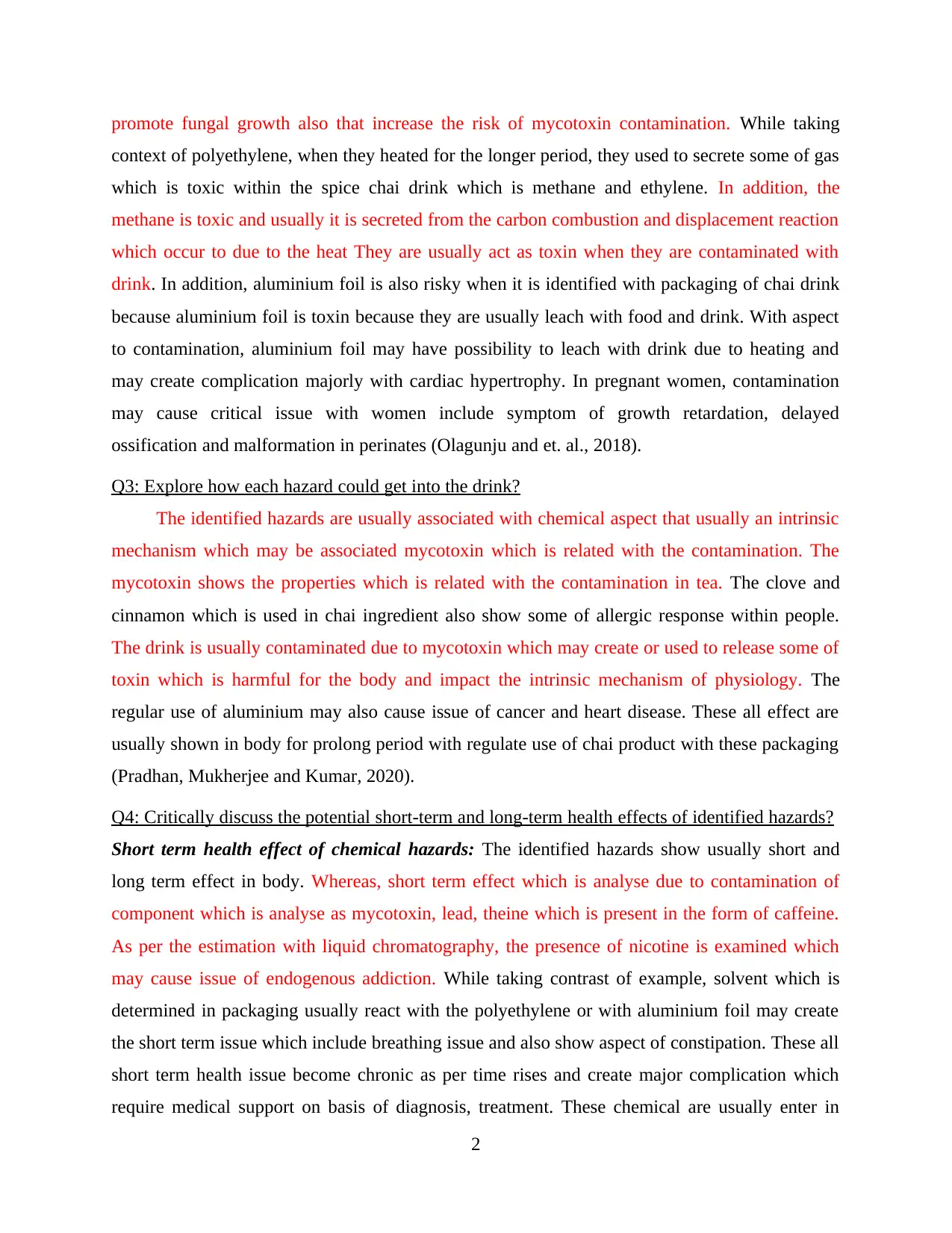
promote fungal growth also that increase the risk of mycotoxin contamination. While taking
context of polyethylene, when they heated for the longer period, they used to secrete some of gas
which is toxic within the spice chai drink which is methane and ethylene. In addition, the
methane is toxic and usually it is secreted from the carbon combustion and displacement reaction
which occur to due to the heat They are usually act as toxin when they are contaminated with
drink. In addition, aluminium foil is also risky when it is identified with packaging of chai drink
because aluminium foil is toxin because they are usually leach with food and drink. With aspect
to contamination, aluminium foil may have possibility to leach with drink due to heating and
may create complication majorly with cardiac hypertrophy. In pregnant women, contamination
may cause critical issue with women include symptom of growth retardation, delayed
ossification and malformation in perinates (Olagunju and et. al., 2018).
Q3: Explore how each hazard could get into the drink?
The identified hazards are usually associated with chemical aspect that usually an intrinsic
mechanism which may be associated mycotoxin which is related with the contamination. The
mycotoxin shows the properties which is related with the contamination in tea. The clove and
cinnamon which is used in chai ingredient also show some of allergic response within people.
The drink is usually contaminated due to mycotoxin which may create or used to release some of
toxin which is harmful for the body and impact the intrinsic mechanism of physiology. The
regular use of aluminium may also cause issue of cancer and heart disease. These all effect are
usually shown in body for prolong period with regulate use of chai product with these packaging
(Pradhan, Mukherjee and Kumar, 2020).
Q4: Critically discuss the potential short-term and long-term health effects of identified hazards?
Short term health effect of chemical hazards: The identified hazards show usually short and
long term effect in body. Whereas, short term effect which is analyse due to contamination of
component which is analyse as mycotoxin, lead, theine which is present in the form of caffeine.
As per the estimation with liquid chromatography, the presence of nicotine is examined which
may cause issue of endogenous addiction. While taking contrast of example, solvent which is
determined in packaging usually react with the polyethylene or with aluminium foil may create
the short term issue which include breathing issue and also show aspect of constipation. These all
short term health issue become chronic as per time rises and create major complication which
require medical support on basis of diagnosis, treatment. These chemical are usually enter in
2
context of polyethylene, when they heated for the longer period, they used to secrete some of gas
which is toxic within the spice chai drink which is methane and ethylene. In addition, the
methane is toxic and usually it is secreted from the carbon combustion and displacement reaction
which occur to due to the heat They are usually act as toxin when they are contaminated with
drink. In addition, aluminium foil is also risky when it is identified with packaging of chai drink
because aluminium foil is toxin because they are usually leach with food and drink. With aspect
to contamination, aluminium foil may have possibility to leach with drink due to heating and
may create complication majorly with cardiac hypertrophy. In pregnant women, contamination
may cause critical issue with women include symptom of growth retardation, delayed
ossification and malformation in perinates (Olagunju and et. al., 2018).
Q3: Explore how each hazard could get into the drink?
The identified hazards are usually associated with chemical aspect that usually an intrinsic
mechanism which may be associated mycotoxin which is related with the contamination. The
mycotoxin shows the properties which is related with the contamination in tea. The clove and
cinnamon which is used in chai ingredient also show some of allergic response within people.
The drink is usually contaminated due to mycotoxin which may create or used to release some of
toxin which is harmful for the body and impact the intrinsic mechanism of physiology. The
regular use of aluminium may also cause issue of cancer and heart disease. These all effect are
usually shown in body for prolong period with regulate use of chai product with these packaging
(Pradhan, Mukherjee and Kumar, 2020).
Q4: Critically discuss the potential short-term and long-term health effects of identified hazards?
Short term health effect of chemical hazards: The identified hazards show usually short and
long term effect in body. Whereas, short term effect which is analyse due to contamination of
component which is analyse as mycotoxin, lead, theine which is present in the form of caffeine.
As per the estimation with liquid chromatography, the presence of nicotine is examined which
may cause issue of endogenous addiction. While taking contrast of example, solvent which is
determined in packaging usually react with the polyethylene or with aluminium foil may create
the short term issue which include breathing issue and also show aspect of constipation. These all
short term health issue become chronic as per time rises and create major complication which
require medical support on basis of diagnosis, treatment. These chemical are usually enter in
2
Secure Best Marks with AI Grader
Need help grading? Try our AI Grader for instant feedback on your assignments.
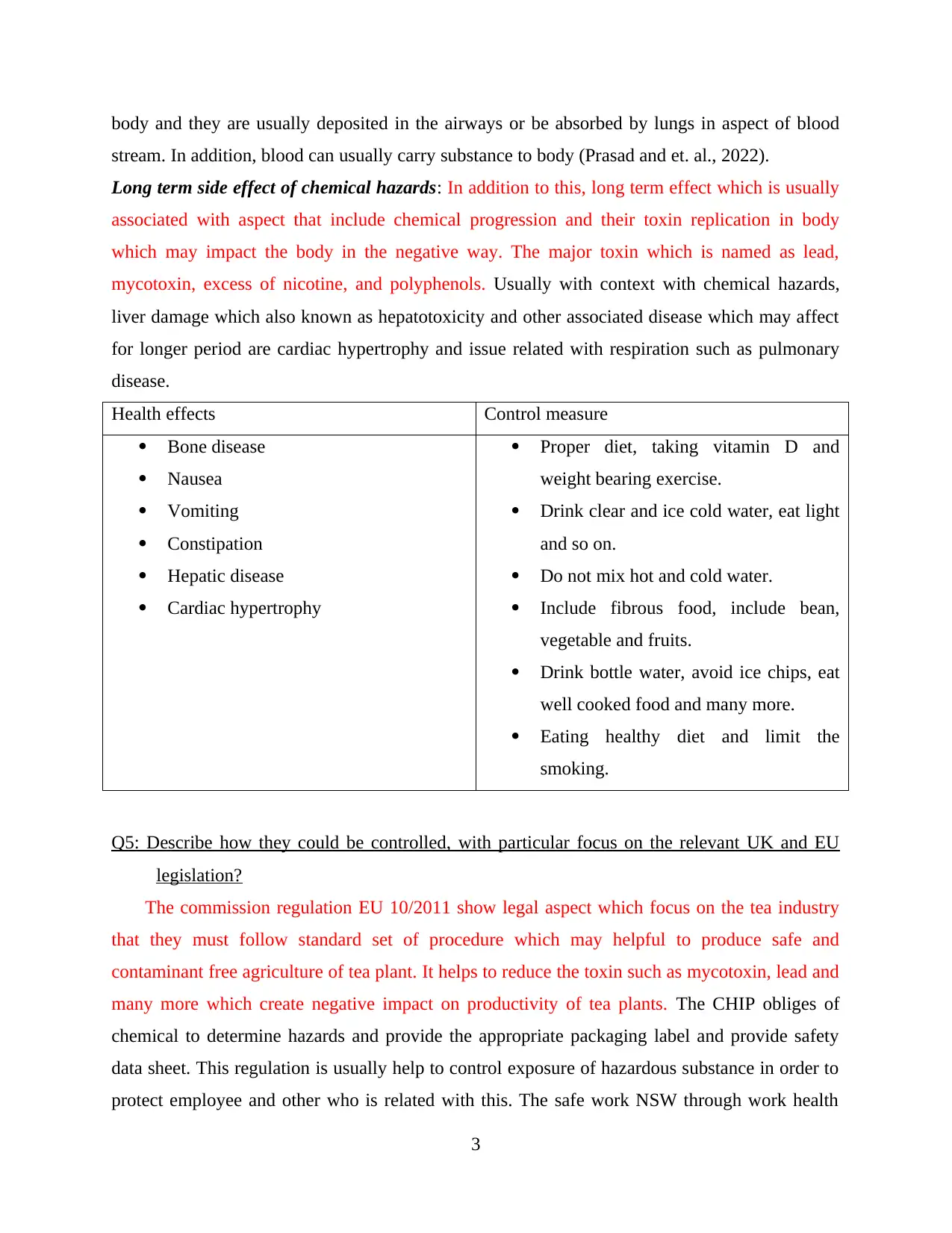
body and they are usually deposited in the airways or be absorbed by lungs in aspect of blood
stream. In addition, blood can usually carry substance to body (Prasad and et. al., 2022).
Long term side effect of chemical hazards: In addition to this, long term effect which is usually
associated with aspect that include chemical progression and their toxin replication in body
which may impact the body in the negative way. The major toxin which is named as lead,
mycotoxin, excess of nicotine, and polyphenols. Usually with context with chemical hazards,
liver damage which also known as hepatotoxicity and other associated disease which may affect
for longer period are cardiac hypertrophy and issue related with respiration such as pulmonary
disease.
Health effects Control measure
Bone disease
Nausea
Vomiting
Constipation
Hepatic disease
Cardiac hypertrophy
Proper diet, taking vitamin D and
weight bearing exercise.
Drink clear and ice cold water, eat light
and so on.
Do not mix hot and cold water.
Include fibrous food, include bean,
vegetable and fruits.
Drink bottle water, avoid ice chips, eat
well cooked food and many more.
Eating healthy diet and limit the
smoking.
Q5: Describe how they could be controlled, with particular focus on the relevant UK and EU
legislation?
The commission regulation EU 10/2011 show legal aspect which focus on the tea industry
that they must follow standard set of procedure which may helpful to produce safe and
contaminant free agriculture of tea plant. It helps to reduce the toxin such as mycotoxin, lead and
many more which create negative impact on productivity of tea plants. The CHIP obliges of
chemical to determine hazards and provide the appropriate packaging label and provide safety
data sheet. This regulation is usually help to control exposure of hazardous substance in order to
protect employee and other who is related with this. The safe work NSW through work health
3
stream. In addition, blood can usually carry substance to body (Prasad and et. al., 2022).
Long term side effect of chemical hazards: In addition to this, long term effect which is usually
associated with aspect that include chemical progression and their toxin replication in body
which may impact the body in the negative way. The major toxin which is named as lead,
mycotoxin, excess of nicotine, and polyphenols. Usually with context with chemical hazards,
liver damage which also known as hepatotoxicity and other associated disease which may affect
for longer period are cardiac hypertrophy and issue related with respiration such as pulmonary
disease.
Health effects Control measure
Bone disease
Nausea
Vomiting
Constipation
Hepatic disease
Cardiac hypertrophy
Proper diet, taking vitamin D and
weight bearing exercise.
Drink clear and ice cold water, eat light
and so on.
Do not mix hot and cold water.
Include fibrous food, include bean,
vegetable and fruits.
Drink bottle water, avoid ice chips, eat
well cooked food and many more.
Eating healthy diet and limit the
smoking.
Q5: Describe how they could be controlled, with particular focus on the relevant UK and EU
legislation?
The commission regulation EU 10/2011 show legal aspect which focus on the tea industry
that they must follow standard set of procedure which may helpful to produce safe and
contaminant free agriculture of tea plant. It helps to reduce the toxin such as mycotoxin, lead and
many more which create negative impact on productivity of tea plants. The CHIP obliges of
chemical to determine hazards and provide the appropriate packaging label and provide safety
data sheet. This regulation is usually help to control exposure of hazardous substance in order to
protect employee and other who is related with this. The safe work NSW through work health
3
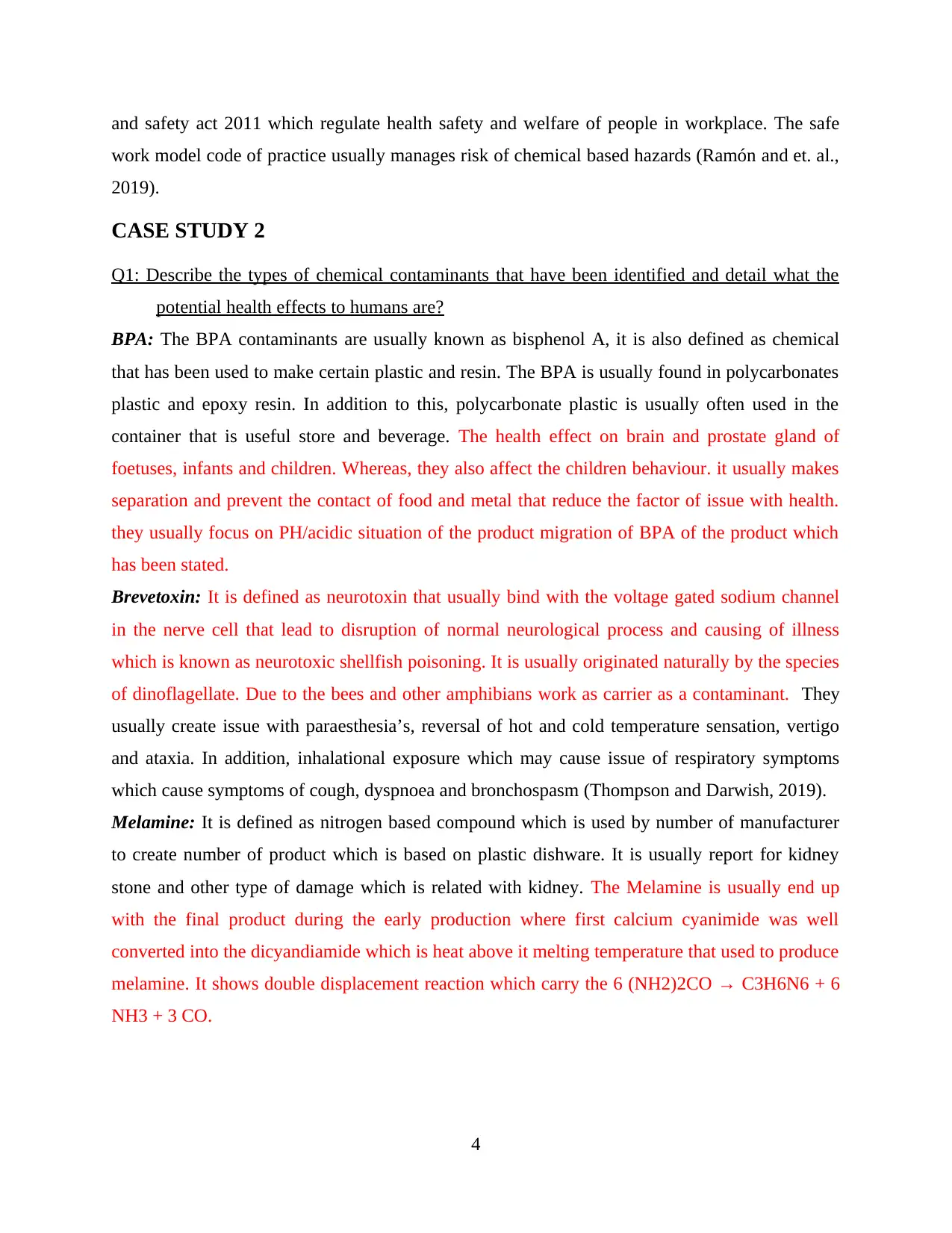
and safety act 2011 which regulate health safety and welfare of people in workplace. The safe
work model code of practice usually manages risk of chemical based hazards (Ramón and et. al.,
2019).
CASE STUDY 2
Q1: Describe the types of chemical contaminants that have been identified and detail what the
potential health effects to humans are?
BPA: The BPA contaminants are usually known as bisphenol A, it is also defined as chemical
that has been used to make certain plastic and resin. The BPA is usually found in polycarbonates
plastic and epoxy resin. In addition to this, polycarbonate plastic is usually often used in the
container that is useful store and beverage. The health effect on brain and prostate gland of
foetuses, infants and children. Whereas, they also affect the children behaviour. it usually makes
separation and prevent the contact of food and metal that reduce the factor of issue with health.
they usually focus on PH/acidic situation of the product migration of BPA of the product which
has been stated.
Brevetoxin: It is defined as neurotoxin that usually bind with the voltage gated sodium channel
in the nerve cell that lead to disruption of normal neurological process and causing of illness
which is known as neurotoxic shellfish poisoning. It is usually originated naturally by the species
of dinoflagellate. Due to the bees and other amphibians work as carrier as a contaminant. They
usually create issue with paraesthesia’s, reversal of hot and cold temperature sensation, vertigo
and ataxia. In addition, inhalational exposure which may cause issue of respiratory symptoms
which cause symptoms of cough, dyspnoea and bronchospasm (Thompson and Darwish, 2019).
Melamine: It is defined as nitrogen based compound which is used by number of manufacturer
to create number of product which is based on plastic dishware. It is usually report for kidney
stone and other type of damage which is related with kidney. The Melamine is usually end up
with the final product during the early production where first calcium cyanimide was well
converted into the dicyandiamide which is heat above it melting temperature that used to produce
melamine. It shows double displacement reaction which carry the 6 (NH2)2CO → C3H6N6 + 6
NH3 + 3 CO.
4
work model code of practice usually manages risk of chemical based hazards (Ramón and et. al.,
2019).
CASE STUDY 2
Q1: Describe the types of chemical contaminants that have been identified and detail what the
potential health effects to humans are?
BPA: The BPA contaminants are usually known as bisphenol A, it is also defined as chemical
that has been used to make certain plastic and resin. The BPA is usually found in polycarbonates
plastic and epoxy resin. In addition to this, polycarbonate plastic is usually often used in the
container that is useful store and beverage. The health effect on brain and prostate gland of
foetuses, infants and children. Whereas, they also affect the children behaviour. it usually makes
separation and prevent the contact of food and metal that reduce the factor of issue with health.
they usually focus on PH/acidic situation of the product migration of BPA of the product which
has been stated.
Brevetoxin: It is defined as neurotoxin that usually bind with the voltage gated sodium channel
in the nerve cell that lead to disruption of normal neurological process and causing of illness
which is known as neurotoxic shellfish poisoning. It is usually originated naturally by the species
of dinoflagellate. Due to the bees and other amphibians work as carrier as a contaminant. They
usually create issue with paraesthesia’s, reversal of hot and cold temperature sensation, vertigo
and ataxia. In addition, inhalational exposure which may cause issue of respiratory symptoms
which cause symptoms of cough, dyspnoea and bronchospasm (Thompson and Darwish, 2019).
Melamine: It is defined as nitrogen based compound which is used by number of manufacturer
to create number of product which is based on plastic dishware. It is usually report for kidney
stone and other type of damage which is related with kidney. The Melamine is usually end up
with the final product during the early production where first calcium cyanimide was well
converted into the dicyandiamide which is heat above it melting temperature that used to produce
melamine. It shows double displacement reaction which carry the 6 (NH2)2CO → C3H6N6 + 6
NH3 + 3 CO.
4
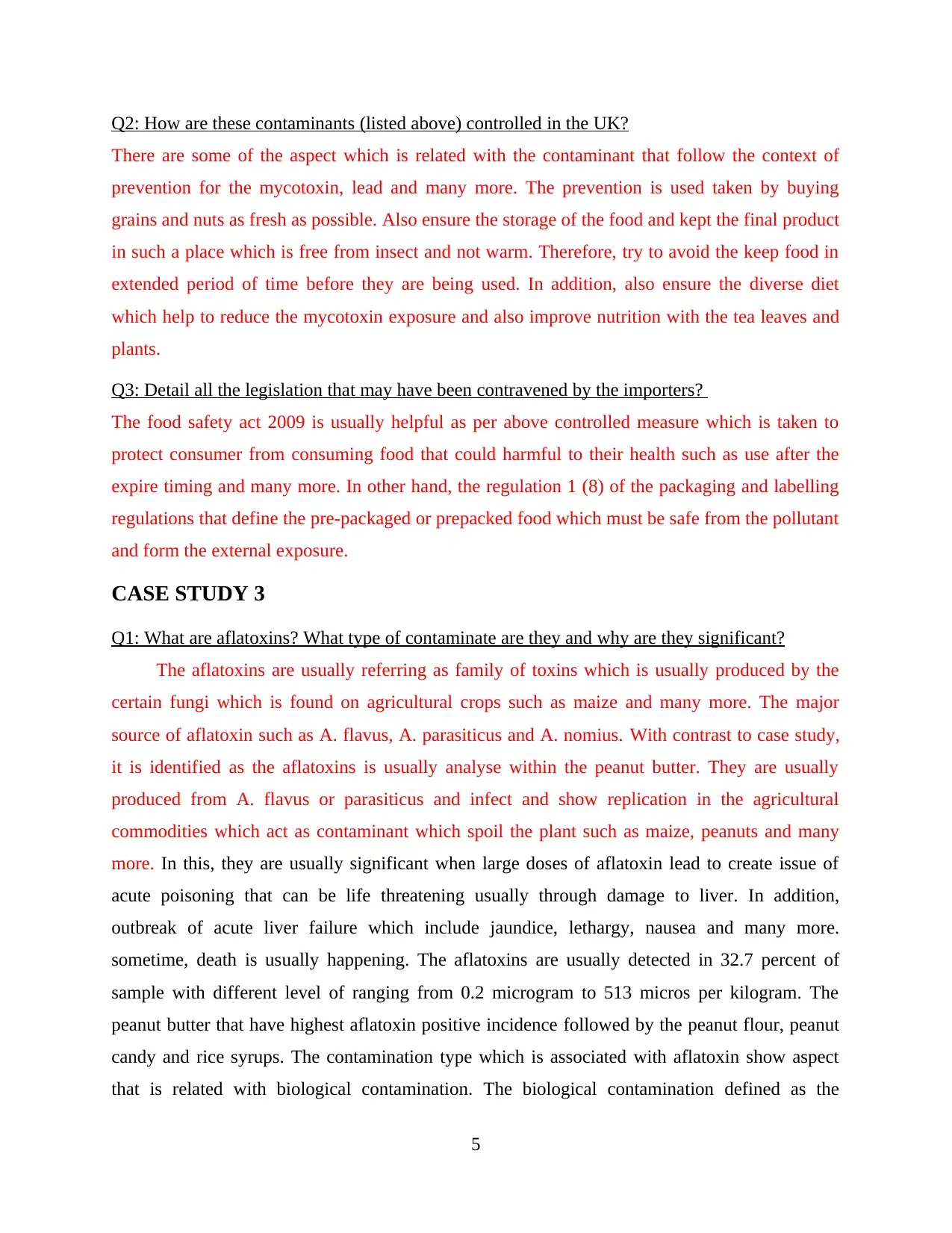
Q2: How are these contaminants (listed above) controlled in the UK?
There are some of the aspect which is related with the contaminant that follow the context of
prevention for the mycotoxin, lead and many more. The prevention is used taken by buying
grains and nuts as fresh as possible. Also ensure the storage of the food and kept the final product
in such a place which is free from insect and not warm. Therefore, try to avoid the keep food in
extended period of time before they are being used. In addition, also ensure the diverse diet
which help to reduce the mycotoxin exposure and also improve nutrition with the tea leaves and
plants.
Q3: Detail all the legislation that may have been contravened by the importers?
The food safety act 2009 is usually helpful as per above controlled measure which is taken to
protect consumer from consuming food that could harmful to their health such as use after the
expire timing and many more. In other hand, the regulation 1 (8) of the packaging and labelling
regulations that define the pre-packaged or prepacked food which must be safe from the pollutant
and form the external exposure.
CASE STUDY 3
Q1: What are aflatoxins? What type of contaminate are they and why are they significant?
The aflatoxins are usually referring as family of toxins which is usually produced by the
certain fungi which is found on agricultural crops such as maize and many more. The major
source of aflatoxin such as A. flavus, A. parasiticus and A. nomius. With contrast to case study,
it is identified as the aflatoxins is usually analyse within the peanut butter. They are usually
produced from A. flavus or parasiticus and infect and show replication in the agricultural
commodities which act as contaminant which spoil the plant such as maize, peanuts and many
more. In this, they are usually significant when large doses of aflatoxin lead to create issue of
acute poisoning that can be life threatening usually through damage to liver. In addition,
outbreak of acute liver failure which include jaundice, lethargy, nausea and many more.
sometime, death is usually happening. The aflatoxins are usually detected in 32.7 percent of
sample with different level of ranging from 0.2 microgram to 513 micros per kilogram. The
peanut butter that have highest aflatoxin positive incidence followed by the peanut flour, peanut
candy and rice syrups. The contamination type which is associated with aflatoxin show aspect
that is related with biological contamination. The biological contamination defined as the
5
There are some of the aspect which is related with the contaminant that follow the context of
prevention for the mycotoxin, lead and many more. The prevention is used taken by buying
grains and nuts as fresh as possible. Also ensure the storage of the food and kept the final product
in such a place which is free from insect and not warm. Therefore, try to avoid the keep food in
extended period of time before they are being used. In addition, also ensure the diverse diet
which help to reduce the mycotoxin exposure and also improve nutrition with the tea leaves and
plants.
Q3: Detail all the legislation that may have been contravened by the importers?
The food safety act 2009 is usually helpful as per above controlled measure which is taken to
protect consumer from consuming food that could harmful to their health such as use after the
expire timing and many more. In other hand, the regulation 1 (8) of the packaging and labelling
regulations that define the pre-packaged or prepacked food which must be safe from the pollutant
and form the external exposure.
CASE STUDY 3
Q1: What are aflatoxins? What type of contaminate are they and why are they significant?
The aflatoxins are usually referring as family of toxins which is usually produced by the
certain fungi which is found on agricultural crops such as maize and many more. The major
source of aflatoxin such as A. flavus, A. parasiticus and A. nomius. With contrast to case study,
it is identified as the aflatoxins is usually analyse within the peanut butter. They are usually
produced from A. flavus or parasiticus and infect and show replication in the agricultural
commodities which act as contaminant which spoil the plant such as maize, peanuts and many
more. In this, they are usually significant when large doses of aflatoxin lead to create issue of
acute poisoning that can be life threatening usually through damage to liver. In addition,
outbreak of acute liver failure which include jaundice, lethargy, nausea and many more.
sometime, death is usually happening. The aflatoxins are usually detected in 32.7 percent of
sample with different level of ranging from 0.2 microgram to 513 micros per kilogram. The
peanut butter that have highest aflatoxin positive incidence followed by the peanut flour, peanut
candy and rice syrups. The contamination type which is associated with aflatoxin show aspect
that is related with biological contamination. The biological contamination defined as the
5
Paraphrase This Document
Need a fresh take? Get an instant paraphrase of this document with our AI Paraphraser
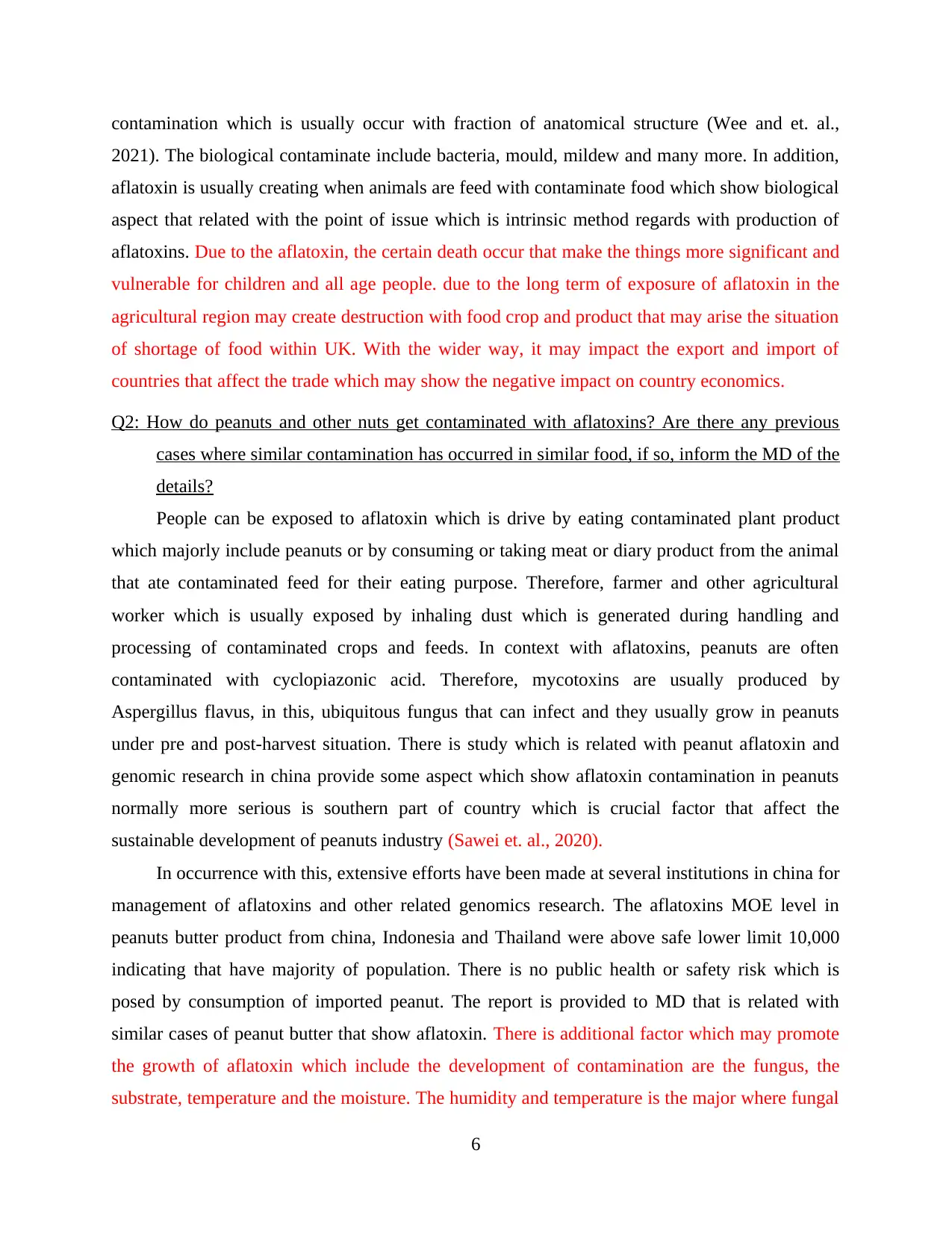
contamination which is usually occur with fraction of anatomical structure (Wee and et. al.,
2021). The biological contaminate include bacteria, mould, mildew and many more. In addition,
aflatoxin is usually creating when animals are feed with contaminate food which show biological
aspect that related with the point of issue which is intrinsic method regards with production of
aflatoxins. Due to the aflatoxin, the certain death occur that make the things more significant and
vulnerable for children and all age people. due to the long term of exposure of aflatoxin in the
agricultural region may create destruction with food crop and product that may arise the situation
of shortage of food within UK. With the wider way, it may impact the export and import of
countries that affect the trade which may show the negative impact on country economics.
Q2: How do peanuts and other nuts get contaminated with aflatoxins? Are there any previous
cases where similar contamination has occurred in similar food, if so, inform the MD of the
details?
People can be exposed to aflatoxin which is drive by eating contaminated plant product
which majorly include peanuts or by consuming or taking meat or diary product from the animal
that ate contaminated feed for their eating purpose. Therefore, farmer and other agricultural
worker which is usually exposed by inhaling dust which is generated during handling and
processing of contaminated crops and feeds. In context with aflatoxins, peanuts are often
contaminated with cyclopiazonic acid. Therefore, mycotoxins are usually produced by
Aspergillus flavus, in this, ubiquitous fungus that can infect and they usually grow in peanuts
under pre and post-harvest situation. There is study which is related with peanut aflatoxin and
genomic research in china provide some aspect which show aflatoxin contamination in peanuts
normally more serious is southern part of country which is crucial factor that affect the
sustainable development of peanuts industry (Sawei et. al., 2020).
In occurrence with this, extensive efforts have been made at several institutions in china for
management of aflatoxins and other related genomics research. The aflatoxins MOE level in
peanuts butter product from china, Indonesia and Thailand were above safe lower limit 10,000
indicating that have majority of population. There is no public health or safety risk which is
posed by consumption of imported peanut. The report is provided to MD that is related with
similar cases of peanut butter that show aflatoxin. There is additional factor which may promote
the growth of aflatoxin which include the development of contamination are the fungus, the
substrate, temperature and the moisture. The humidity and temperature is the major where fungal
6
2021). The biological contaminate include bacteria, mould, mildew and many more. In addition,
aflatoxin is usually creating when animals are feed with contaminate food which show biological
aspect that related with the point of issue which is intrinsic method regards with production of
aflatoxins. Due to the aflatoxin, the certain death occur that make the things more significant and
vulnerable for children and all age people. due to the long term of exposure of aflatoxin in the
agricultural region may create destruction with food crop and product that may arise the situation
of shortage of food within UK. With the wider way, it may impact the export and import of
countries that affect the trade which may show the negative impact on country economics.
Q2: How do peanuts and other nuts get contaminated with aflatoxins? Are there any previous
cases where similar contamination has occurred in similar food, if so, inform the MD of the
details?
People can be exposed to aflatoxin which is drive by eating contaminated plant product
which majorly include peanuts or by consuming or taking meat or diary product from the animal
that ate contaminated feed for their eating purpose. Therefore, farmer and other agricultural
worker which is usually exposed by inhaling dust which is generated during handling and
processing of contaminated crops and feeds. In context with aflatoxins, peanuts are often
contaminated with cyclopiazonic acid. Therefore, mycotoxins are usually produced by
Aspergillus flavus, in this, ubiquitous fungus that can infect and they usually grow in peanuts
under pre and post-harvest situation. There is study which is related with peanut aflatoxin and
genomic research in china provide some aspect which show aflatoxin contamination in peanuts
normally more serious is southern part of country which is crucial factor that affect the
sustainable development of peanuts industry (Sawei et. al., 2020).
In occurrence with this, extensive efforts have been made at several institutions in china for
management of aflatoxins and other related genomics research. The aflatoxins MOE level in
peanuts butter product from china, Indonesia and Thailand were above safe lower limit 10,000
indicating that have majority of population. There is no public health or safety risk which is
posed by consumption of imported peanut. The report is provided to MD that is related with
similar cases of peanut butter that show aflatoxin. There is additional factor which may promote
the growth of aflatoxin which include the development of contamination are the fungus, the
substrate, temperature and the moisture. The humidity and temperature is the major where fungal
6
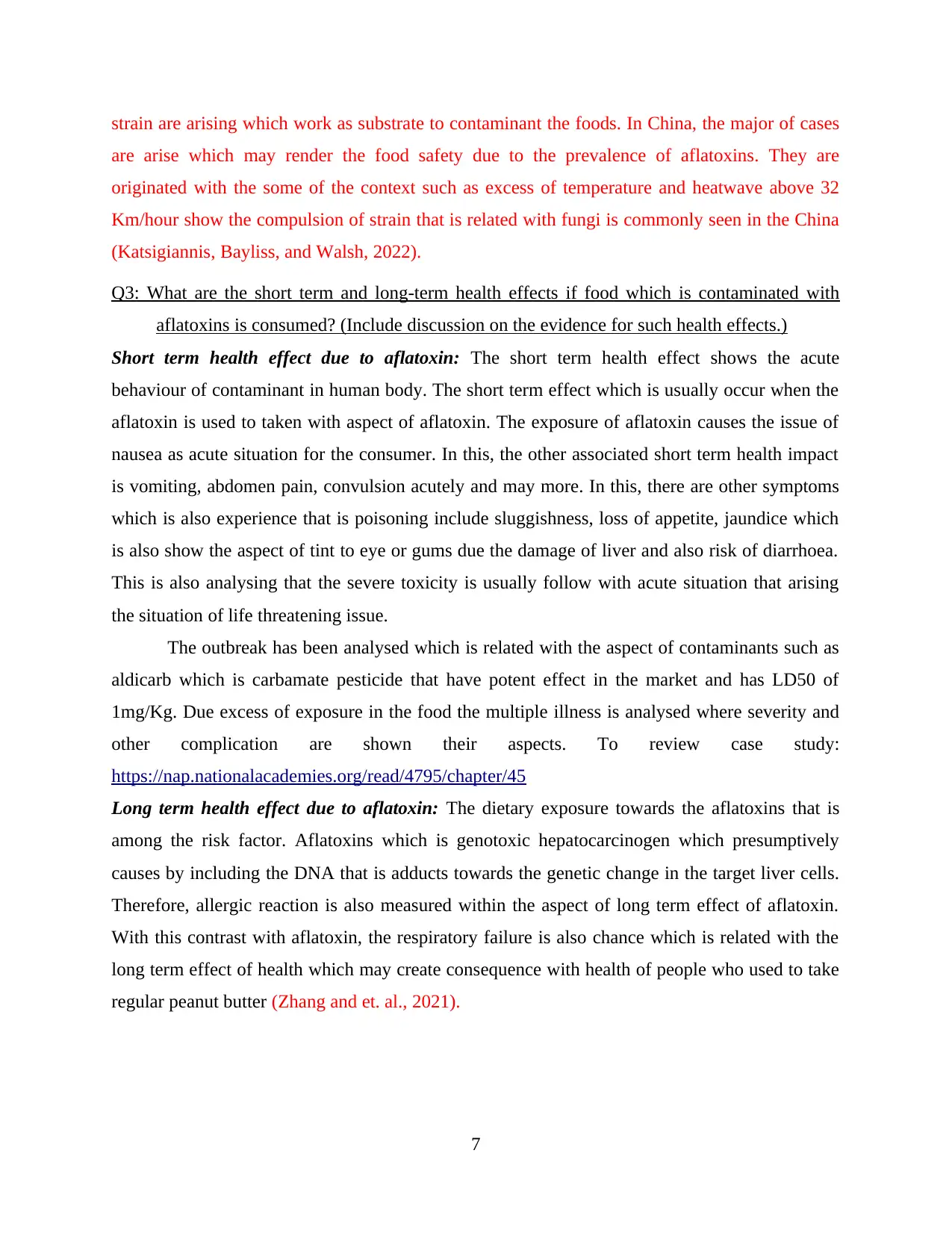
strain are arising which work as substrate to contaminant the foods. In China, the major of cases
are arise which may render the food safety due to the prevalence of aflatoxins. They are
originated with the some of the context such as excess of temperature and heatwave above 32
Km/hour show the compulsion of strain that is related with fungi is commonly seen in the China
(Katsigiannis, Bayliss, and Walsh, 2022).
Q3: What are the short term and long-term health effects if food which is contaminated with
aflatoxins is consumed? (Include discussion on the evidence for such health effects.)
Short term health effect due to aflatoxin: The short term health effect shows the acute
behaviour of contaminant in human body. The short term effect which is usually occur when the
aflatoxin is used to taken with aspect of aflatoxin. The exposure of aflatoxin causes the issue of
nausea as acute situation for the consumer. In this, the other associated short term health impact
is vomiting, abdomen pain, convulsion acutely and may more. In this, there are other symptoms
which is also experience that is poisoning include sluggishness, loss of appetite, jaundice which
is also show the aspect of tint to eye or gums due the damage of liver and also risk of diarrhoea.
This is also analysing that the severe toxicity is usually follow with acute situation that arising
the situation of life threatening issue.
The outbreak has been analysed which is related with the aspect of contaminants such as
aldicarb which is carbamate pesticide that have potent effect in the market and has LD50 of
1mg/Kg. Due excess of exposure in the food the multiple illness is analysed where severity and
other complication are shown their aspects. To review case study:
https://nap.nationalacademies.org/read/4795/chapter/45
Long term health effect due to aflatoxin: The dietary exposure towards the aflatoxins that is
among the risk factor. Aflatoxins which is genotoxic hepatocarcinogen which presumptively
causes by including the DNA that is adducts towards the genetic change in the target liver cells.
Therefore, allergic reaction is also measured within the aspect of long term effect of aflatoxin.
With this contrast with aflatoxin, the respiratory failure is also chance which is related with the
long term effect of health which may create consequence with health of people who used to take
regular peanut butter (Zhang and et. al., 2021).
7
are arise which may render the food safety due to the prevalence of aflatoxins. They are
originated with the some of the context such as excess of temperature and heatwave above 32
Km/hour show the compulsion of strain that is related with fungi is commonly seen in the China
(Katsigiannis, Bayliss, and Walsh, 2022).
Q3: What are the short term and long-term health effects if food which is contaminated with
aflatoxins is consumed? (Include discussion on the evidence for such health effects.)
Short term health effect due to aflatoxin: The short term health effect shows the acute
behaviour of contaminant in human body. The short term effect which is usually occur when the
aflatoxin is used to taken with aspect of aflatoxin. The exposure of aflatoxin causes the issue of
nausea as acute situation for the consumer. In this, the other associated short term health impact
is vomiting, abdomen pain, convulsion acutely and may more. In this, there are other symptoms
which is also experience that is poisoning include sluggishness, loss of appetite, jaundice which
is also show the aspect of tint to eye or gums due the damage of liver and also risk of diarrhoea.
This is also analysing that the severe toxicity is usually follow with acute situation that arising
the situation of life threatening issue.
The outbreak has been analysed which is related with the aspect of contaminants such as
aldicarb which is carbamate pesticide that have potent effect in the market and has LD50 of
1mg/Kg. Due excess of exposure in the food the multiple illness is analysed where severity and
other complication are shown their aspects. To review case study:
https://nap.nationalacademies.org/read/4795/chapter/45
Long term health effect due to aflatoxin: The dietary exposure towards the aflatoxins that is
among the risk factor. Aflatoxins which is genotoxic hepatocarcinogen which presumptively
causes by including the DNA that is adducts towards the genetic change in the target liver cells.
Therefore, allergic reaction is also measured within the aspect of long term effect of aflatoxin.
With this contrast with aflatoxin, the respiratory failure is also chance which is related with the
long term effect of health which may create consequence with health of people who used to take
regular peanut butter (Zhang and et. al., 2021).
7
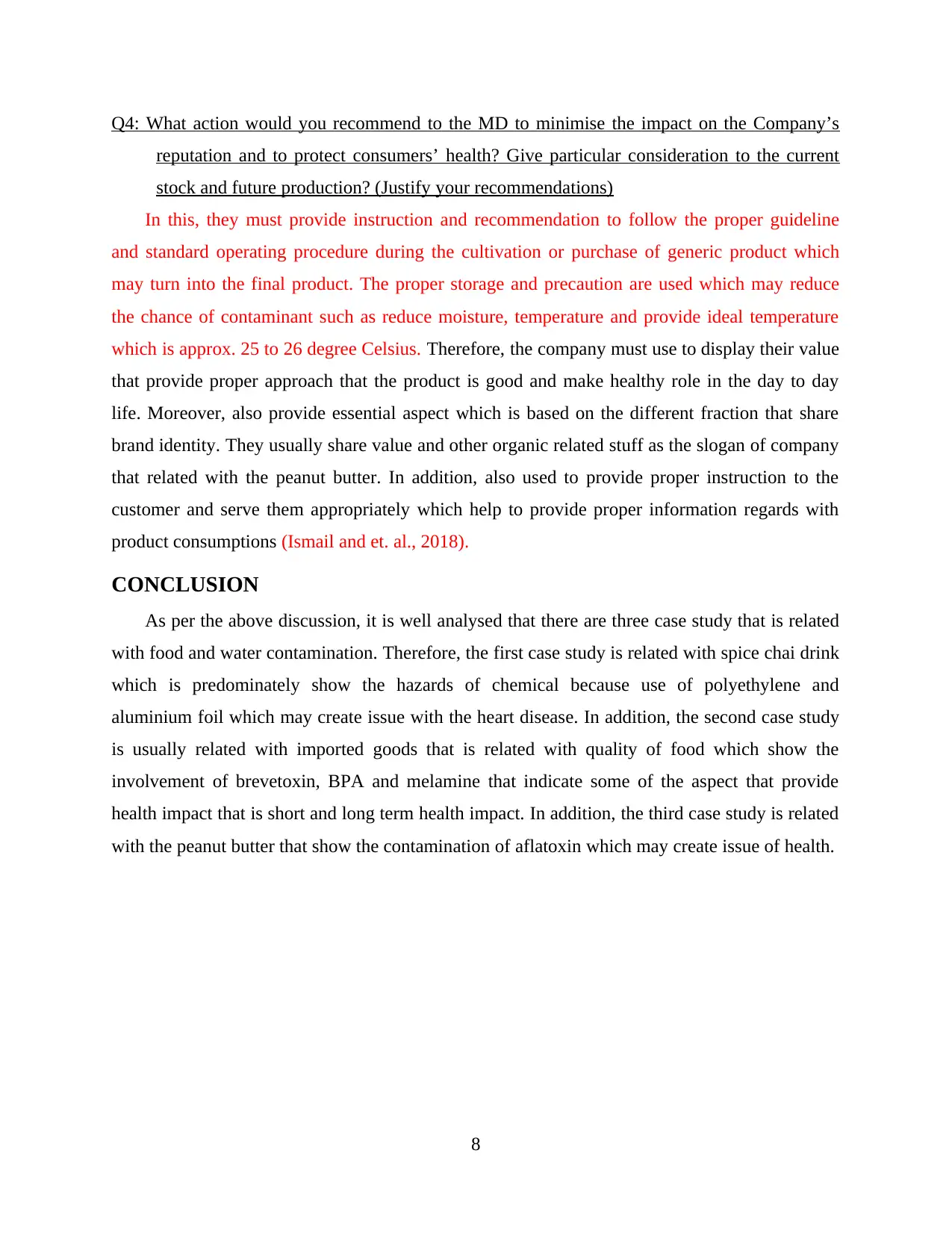
Q4: What action would you recommend to the MD to minimise the impact on the Company’s
reputation and to protect consumers’ health? Give particular consideration to the current
stock and future production? (Justify your recommendations)
In this, they must provide instruction and recommendation to follow the proper guideline
and standard operating procedure during the cultivation or purchase of generic product which
may turn into the final product. The proper storage and precaution are used which may reduce
the chance of contaminant such as reduce moisture, temperature and provide ideal temperature
which is approx. 25 to 26 degree Celsius. Therefore, the company must use to display their value
that provide proper approach that the product is good and make healthy role in the day to day
life. Moreover, also provide essential aspect which is based on the different fraction that share
brand identity. They usually share value and other organic related stuff as the slogan of company
that related with the peanut butter. In addition, also used to provide proper instruction to the
customer and serve them appropriately which help to provide proper information regards with
product consumptions (Ismail and et. al., 2018).
CONCLUSION
As per the above discussion, it is well analysed that there are three case study that is related
with food and water contamination. Therefore, the first case study is related with spice chai drink
which is predominately show the hazards of chemical because use of polyethylene and
aluminium foil which may create issue with the heart disease. In addition, the second case study
is usually related with imported goods that is related with quality of food which show the
involvement of brevetoxin, BPA and melamine that indicate some of the aspect that provide
health impact that is short and long term health impact. In addition, the third case study is related
with the peanut butter that show the contamination of aflatoxin which may create issue of health.
8
reputation and to protect consumers’ health? Give particular consideration to the current
stock and future production? (Justify your recommendations)
In this, they must provide instruction and recommendation to follow the proper guideline
and standard operating procedure during the cultivation or purchase of generic product which
may turn into the final product. The proper storage and precaution are used which may reduce
the chance of contaminant such as reduce moisture, temperature and provide ideal temperature
which is approx. 25 to 26 degree Celsius. Therefore, the company must use to display their value
that provide proper approach that the product is good and make healthy role in the day to day
life. Moreover, also provide essential aspect which is based on the different fraction that share
brand identity. They usually share value and other organic related stuff as the slogan of company
that related with the peanut butter. In addition, also used to provide proper instruction to the
customer and serve them appropriately which help to provide proper information regards with
product consumptions (Ismail and et. al., 2018).
CONCLUSION
As per the above discussion, it is well analysed that there are three case study that is related
with food and water contamination. Therefore, the first case study is related with spice chai drink
which is predominately show the hazards of chemical because use of polyethylene and
aluminium foil which may create issue with the heart disease. In addition, the second case study
is usually related with imported goods that is related with quality of food which show the
involvement of brevetoxin, BPA and melamine that indicate some of the aspect that provide
health impact that is short and long term health impact. In addition, the third case study is related
with the peanut butter that show the contamination of aflatoxin which may create issue of health.
8
Secure Best Marks with AI Grader
Need help grading? Try our AI Grader for instant feedback on your assignments.
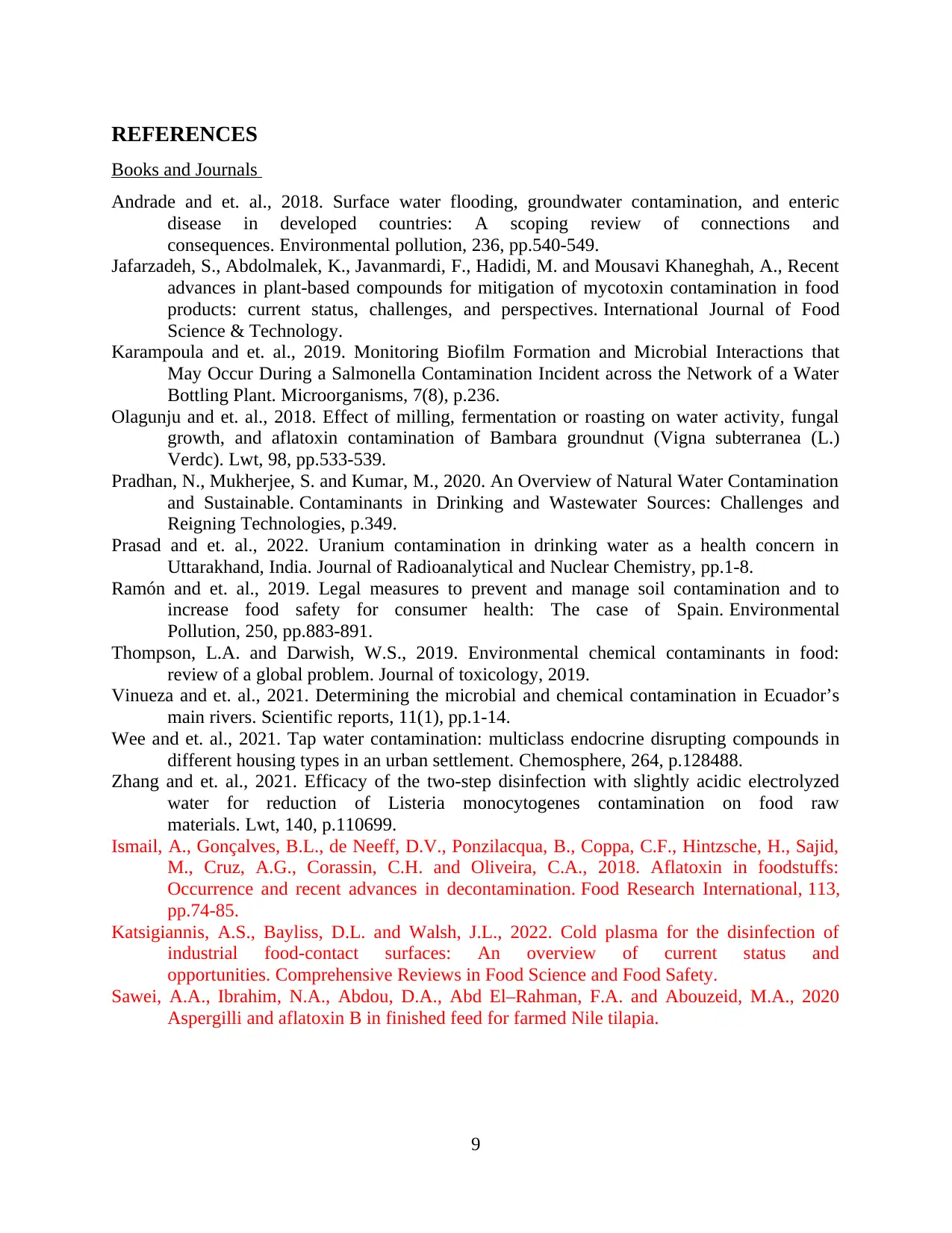
REFERENCES
Books and Journals
Andrade and et. al., 2018. Surface water flooding, groundwater contamination, and enteric
disease in developed countries: A scoping review of connections and
consequences. Environmental pollution, 236, pp.540-549.
Jafarzadeh, S., Abdolmalek, K., Javanmardi, F., Hadidi, M. and Mousavi Khaneghah, A., Recent
advances in plant‐based compounds for mitigation of mycotoxin contamination in food
products: current status, challenges, and perspectives. International Journal of Food
Science & Technology.
Karampoula and et. al., 2019. Monitoring Biofilm Formation and Microbial Interactions that
May Occur During a Salmonella Contamination Incident across the Network of a Water
Bottling Plant. Microorganisms, 7(8), p.236.
Olagunju and et. al., 2018. Effect of milling, fermentation or roasting on water activity, fungal
growth, and aflatoxin contamination of Bambara groundnut (Vigna subterranea (L.)
Verdc). Lwt, 98, pp.533-539.
Pradhan, N., Mukherjee, S. and Kumar, M., 2020. An Overview of Natural Water Contamination
and Sustainable. Contaminants in Drinking and Wastewater Sources: Challenges and
Reigning Technologies, p.349.
Prasad and et. al., 2022. Uranium contamination in drinking water as a health concern in
Uttarakhand, India. Journal of Radioanalytical and Nuclear Chemistry, pp.1-8.
Ramón and et. al., 2019. Legal measures to prevent and manage soil contamination and to
increase food safety for consumer health: The case of Spain. Environmental
Pollution, 250, pp.883-891.
Thompson, L.A. and Darwish, W.S., 2019. Environmental chemical contaminants in food:
review of a global problem. Journal of toxicology, 2019.
Vinueza and et. al., 2021. Determining the microbial and chemical contamination in Ecuador’s
main rivers. Scientific reports, 11(1), pp.1-14.
Wee and et. al., 2021. Tap water contamination: multiclass endocrine disrupting compounds in
different housing types in an urban settlement. Chemosphere, 264, p.128488.
Zhang and et. al., 2021. Efficacy of the two-step disinfection with slightly acidic electrolyzed
water for reduction of Listeria monocytogenes contamination on food raw
materials. Lwt, 140, p.110699.
Ismail, A., Gonçalves, B.L., de Neeff, D.V., Ponzilacqua, B., Coppa, C.F., Hintzsche, H., Sajid,
M., Cruz, A.G., Corassin, C.H. and Oliveira, C.A., 2018. Aflatoxin in foodstuffs:
Occurrence and recent advances in decontamination. Food Research International, 113,
pp.74-85.
Katsigiannis, A.S., Bayliss, D.L. and Walsh, J.L., 2022. Cold plasma for the disinfection of
industrial food‐contact surfaces: An overview of current status and
opportunities. Comprehensive Reviews in Food Science and Food Safety.
Sawei, A.A., Ibrahim, N.A., Abdou, D.A., Abd El–Rahman, F.A. and Abouzeid, M.A., 2020
Aspergilli and aflatoxin B in finished feed for farmed Nile tilapia.
9
Books and Journals
Andrade and et. al., 2018. Surface water flooding, groundwater contamination, and enteric
disease in developed countries: A scoping review of connections and
consequences. Environmental pollution, 236, pp.540-549.
Jafarzadeh, S., Abdolmalek, K., Javanmardi, F., Hadidi, M. and Mousavi Khaneghah, A., Recent
advances in plant‐based compounds for mitigation of mycotoxin contamination in food
products: current status, challenges, and perspectives. International Journal of Food
Science & Technology.
Karampoula and et. al., 2019. Monitoring Biofilm Formation and Microbial Interactions that
May Occur During a Salmonella Contamination Incident across the Network of a Water
Bottling Plant. Microorganisms, 7(8), p.236.
Olagunju and et. al., 2018. Effect of milling, fermentation or roasting on water activity, fungal
growth, and aflatoxin contamination of Bambara groundnut (Vigna subterranea (L.)
Verdc). Lwt, 98, pp.533-539.
Pradhan, N., Mukherjee, S. and Kumar, M., 2020. An Overview of Natural Water Contamination
and Sustainable. Contaminants in Drinking and Wastewater Sources: Challenges and
Reigning Technologies, p.349.
Prasad and et. al., 2022. Uranium contamination in drinking water as a health concern in
Uttarakhand, India. Journal of Radioanalytical and Nuclear Chemistry, pp.1-8.
Ramón and et. al., 2019. Legal measures to prevent and manage soil contamination and to
increase food safety for consumer health: The case of Spain. Environmental
Pollution, 250, pp.883-891.
Thompson, L.A. and Darwish, W.S., 2019. Environmental chemical contaminants in food:
review of a global problem. Journal of toxicology, 2019.
Vinueza and et. al., 2021. Determining the microbial and chemical contamination in Ecuador’s
main rivers. Scientific reports, 11(1), pp.1-14.
Wee and et. al., 2021. Tap water contamination: multiclass endocrine disrupting compounds in
different housing types in an urban settlement. Chemosphere, 264, p.128488.
Zhang and et. al., 2021. Efficacy of the two-step disinfection with slightly acidic electrolyzed
water for reduction of Listeria monocytogenes contamination on food raw
materials. Lwt, 140, p.110699.
Ismail, A., Gonçalves, B.L., de Neeff, D.V., Ponzilacqua, B., Coppa, C.F., Hintzsche, H., Sajid,
M., Cruz, A.G., Corassin, C.H. and Oliveira, C.A., 2018. Aflatoxin in foodstuffs:
Occurrence and recent advances in decontamination. Food Research International, 113,
pp.74-85.
Katsigiannis, A.S., Bayliss, D.L. and Walsh, J.L., 2022. Cold plasma for the disinfection of
industrial food‐contact surfaces: An overview of current status and
opportunities. Comprehensive Reviews in Food Science and Food Safety.
Sawei, A.A., Ibrahim, N.A., Abdou, D.A., Abd El–Rahman, F.A. and Abouzeid, M.A., 2020
Aspergilli and aflatoxin B in finished feed for farmed Nile tilapia.
9

10
1 out of 12
Your All-in-One AI-Powered Toolkit for Academic Success.
+13062052269
info@desklib.com
Available 24*7 on WhatsApp / Email
![[object Object]](/_next/static/media/star-bottom.7253800d.svg)
Unlock your academic potential
© 2024 | Zucol Services PVT LTD | All rights reserved.

